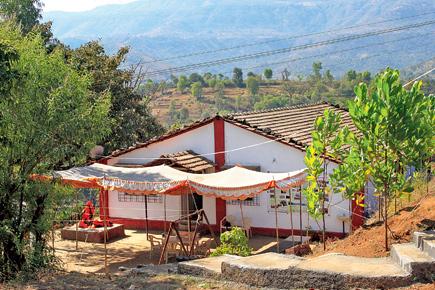A visit to Harchandi, a true-blue Maharashtrian hamlet, not only introduces you to a way of life alien to city folk but also acquaints you to quietude

Do you see that tiny hamlet down there? That’s Harchandi,” says Vijay More, pointing to where we’re headed after our chai break at Shivsagar Point, about 45 minutes beyond Mahabaleshwar. The view of the Nisarg river snaking its way through the ghats is breathtaking. It is still very early in the morning and the nocturnal nightjars’ churring, clicking song is the only sound around us. It is, in a way, a sign of what’s in store for us: tranquility.

The cottage, built on the Mores’ ancestral property, has four bedrooms and can house large groups
ADVERTISEMENT

Uninterrupted by hoardes of tourists, the lake is the picture of calm.
During our drive from Mahableshwar, we realise that despite the presence of boards directing us to our homestay Sakha Niwas, getting there would have been difficult if More hadn’t been with us. The hamlet near Tapola — which tourists might know of as the Kashmir of Maharashtra — houses not more than 80 families, all belonging to the More clan. It is an unlikely tourist spot and most residents scoffed at our young host when he first decided to set up a homestay inviting guests to his ancestral property. It is remote, yes, but that is what has made Harchandi so much more appealing to us.

The view of River Nisarg from Shiv Sagar Point. Pics/Moeena Halim
At first taste
What we have signed up for is the quintessential rural experience and at breakfast we get our first taste of true village life — fresh produce, a hearty meal and a generous dose of hospitality. Along with a plate of poha we are presented with a large bowlful of scarlet-hued strawberries, plucked early that morning. Needless to say we do justice to the deliciously juicy fruit. But this is just the beginning of our strawberry saga. Later that day, we take a walk down to one of the many strawberry farms in the area. We are nearing the end of the season and the little green berries we see hanging over the plastic sheet protecting the soil are probably the last of the lot this year. Vasant More, the farmer, grows a bunch of other veggies — tomatoes, chillies, brinjals and so on. So, when we leave for Mumbai the next morning, not only are we laden with kilos of strawberries we bought from him at a bargain but also with tomatoes enough to provide a feast.

Ruins of an ancient temple lie along the banks of the lake
The village tour
More’s itinerary for us begins with a walking tour of the village. Our first stop is a visit to Tanaji and Sushila More’s home. It worries me that we are invading their privacy, taking in the bric-a-brac in their home as we would exhibits in a museum, but their warm welcome is enough to quash my doubts.

Susheela More welcomed us with sweet black tea made on the traditional chulha
The traditionally-built house is complete with mud flooring and a tiled roof, covered with cakes of cow dung left out to dry. At the entrance, there is a depression in the floor, perfect for pounding rice. We are also fascinated by the chulha, in the centre of the house, which we examine when we are invited in for a cup of sweet black tea.

Lunch was a typically Maharashtrian homemade meal of chicken curry and bhakri, a dry chicken starter and salad
Making our way down to the lake, we pass several other houses just like this one, most of which have a large verandah covered with nilgiri leaves to help bring down the temperature. Waving to a group of seniors sharing their daily dose of gossip, More tells us that he and his wife, who moved back from Mumbai in 2011, are the only youngsters around. “The rest have left the village for bigger cities where they hold jobs. They send money to their parents and come to the village only when their farmland needs attention,” he adds, as we pass a padlocked house.

Fresh strawberries plucked from a strawberry farm nearby
With More’s limited knowledge of birds, we’d all but given up on birdwatching when suddenly we spot a muster of peacocks picking away at the French beans on a nearby farm. “They really can’t do much damage to the crop,” remarks More, even as he begins shooing them away.
Other than a little old lady tending her goats, there’s not a soul in sight at the lake. On the banks, fascinating ruins of an ancient temple leave a lot of questions unanswered. No one in the village knows anything about these and few care enough to find out. The star attraction is the temple buried under the water in the middle of the lake. All we see of it is the flag on the shikhar as we row past it in our little boat. Most guests enjoy a dip in the lake and often indulge in a ‘mud bath’ along the banks.
“It is like applying multani mitti on your skin. It is very good for you,” says More. But an afternoon nap is the indulgence we seek.
At dinner, our chicken-heavy lunch is matched by a butter-laden barbequed chicken meal. We eat under a starlit sky, listening to the nightjars again, watching the moon rise from behind the mountain. Leaving early the next morning seems a feat bigger than we had imagined.
 Subscribe today by clicking the link and stay updated with the latest news!" Click here!
Subscribe today by clicking the link and stay updated with the latest news!" Click here!







